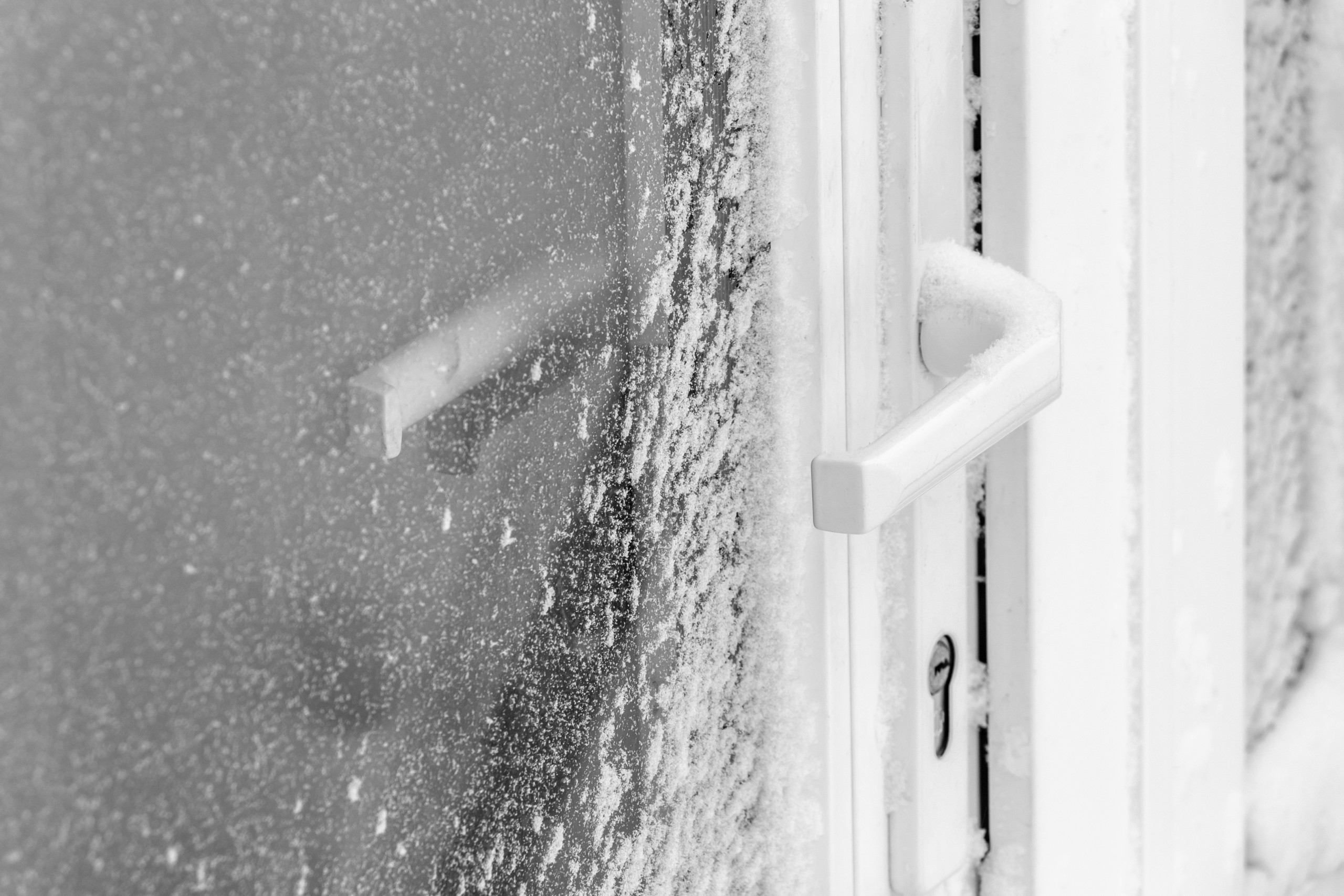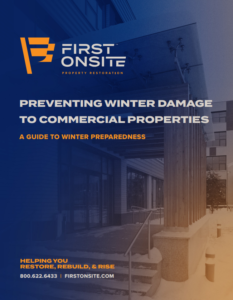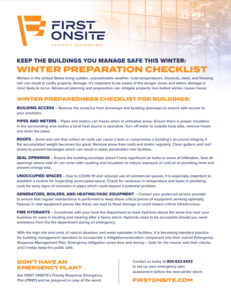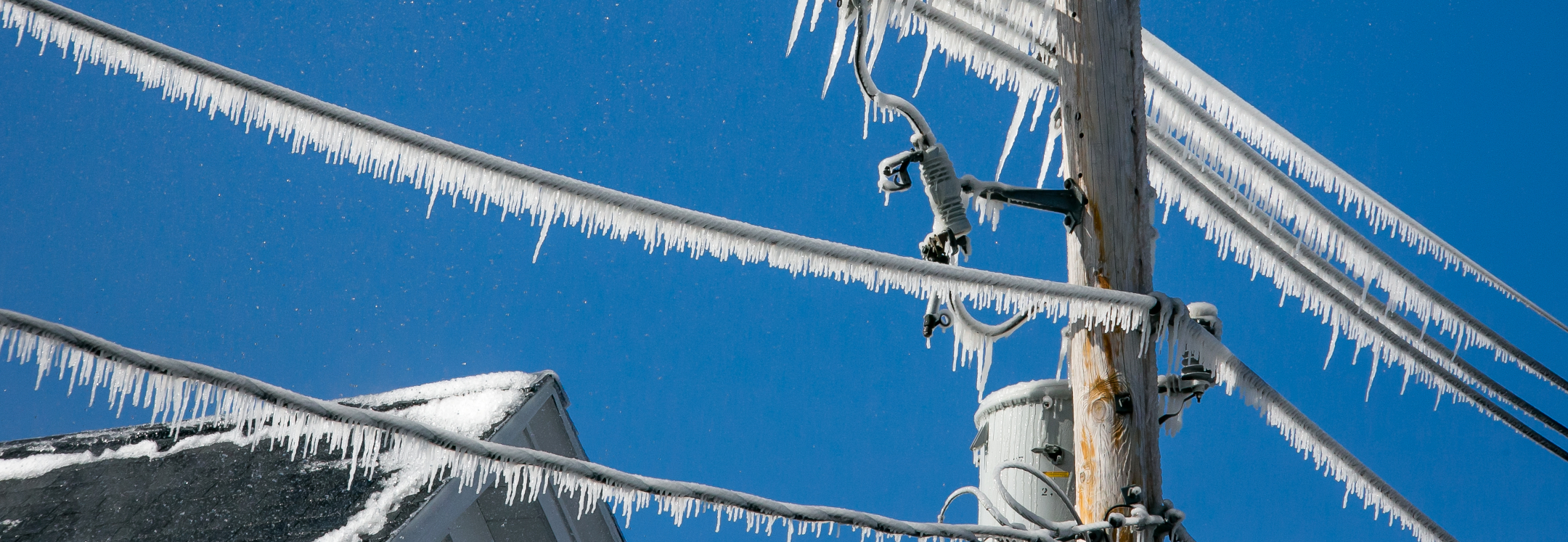What is an ice storm? What happens during an ice storm?
An ice storm is a winter weather event caused by significant accumulations of freezing rain on exposed surfaces – buildings, houses, cars, trees, roadways, etc. Freezing rain occurs when precipitation falling as snow encounters a layer of warm air, melts, then continues falling as rain through a thin layer of freezing air before coming in contact with the ground, structures, and other objects and freezing on contact, creating a “glaze” of ice on all surfaces. Freezing rain resulting in ice accumulation of ¼ inch or more is categorized as an ice storm and will impact travel, result in damage to structures and trees, and can cause power failure. Just ½ inch of ice can burden power lines and tree limbs with hundreds of pounds of added weight, making roadblocks and power outages a common by-product of winter ice events.
Ice Storm Warnings and Freezing Rain Advisories
Issued by the National Weather Service when potentially hazardous conditions due to freezing rain are imminent, Ice Storm Warnings and Freezing Rain Advisories are your first line of defense against winter catastrophe. An Ice Storm Warning indicates expected ice accumulation of at least ¼ inch, while the less serious Freezing Rain Advisory anticipates ice accumulation of up to ¼ inch.
Ice Storm FAQs
- How do ice storms form? When snowfall passes through layers of warm and cold air, it melts and then cools. Upon reaching the frozen surface it comes in contact with, the rain immediately freezes, coating everything it touches with a layer of ice. Events with accumulations of ice above ¼ inch are categorized as ice storms.
- Where – and how frequently – do ice storms occur? The Northeastern and Midwestern states are the most common hot spots for ice storms in the US. Of course, there are notable exceptions. So-called “outlier” events have reached as far as the Southeastern region, even as far as Texas and Oklahoma (as we all saw in February 2021). Canada sees much more frequent winter ice events – averaging 10-15 annually. While these can occur anywhere in the country, Ontario, Quebec, and the Atlantic provinces are the most frequently impacted.
- What time of year do ice storms occur? While possible anytime between November and April – especially as outlier events become more common – most ice storms and freezing rain events occur between December and January.
- How long do ice storms last? While the storm itself can last anywhere from a few hours to several days, the after-effects of winter storms can be long-lasting and even more damaging than the actual storm itself. The massive January 1998 ice storm in eastern Ontario lasted for five days – remarkable and devastating in its own right – but its power outages and clean-up efforts stretched on for weeks and, in some cases, months. The four-day February 2021 Texas freeze saw after-effects lasting over two weeks. It is imperative to keep these extended timelines in mind when preparing for extreme winter weather events.
- What are the dangers of ice storms? Loss of business. And worse, loss of life. Dangerous travel conditions, falling ice and debris, slippery surfaces, improperly ventilated fire and generators, and downed electrical wires – all of these are major contributors to the risk of bodily harm you may encounter after an ice storm. Second only to harm to your person is the potential for damage to your home or place of business due to frozen pipes, falling trees, improper heating methods, and electrical surges.
- How are ice storms measured? The severity of ice storms is measured in two ways – accumulation and duration. Of course, the greater the amount of ice that has accumulated on any surface, the longer it will take to thaw, repair and recover. The length of time a full recovery will take and the number of households and businesses impacted by the storm (and its after-effects) is possibly the most important measure of an ice storm’s intensity. How many businesses were shuttered? Or homes without power? For how many days and nights? And how quickly did they recover?
- When do ice storms end? Once the storm has passed, exercise caution when venturing out. Trees and power lines are likely to be down or unstable. Roads and walkways will surely still be icy. Limit trips away from the home in the first 24-48 hours to only essentials and emergencies. Call 5-1-1 for road and weather updates before leaving and plan your route accordingly.
Power failures due to ice storms
Whether at your place of business or at home, the most impactful element when it comes to withstanding ice storms is power failure. The National Weather Service advises, “Heavy accumulations of ice can bring down trees and topple utility poles and communication towers. Ice can disrupt communications and power for days while utility companies repair extensive damage.” Loss of heat in homes and loss of business in commercial settings, coupled with the risk for frozen and burst pipes and plumbing failures, power outages are the determining factor in just how manageable – or devastating – a winter ice event will be.

RESIDENTIAL
How to prepare for an ice storm
Preparedness will go a long way toward carrying you and your home through a winter weather event.
- Do a visual inspection of the interior and exterior of your home – paying special attention to the condition of safeguards like insulation, caulking and weather stripping.
- Test all smoke and carbon monoxide detectors and change their battery backups.
- Know the preventative measures you can take to avoid frozen pipes in the event of extreme cold. (LINK)
- Pretreating your driveway, walkways and exterior steps with rock salt or a calcium-based deicer before the storm is ideal. Be sure to have plenty on hand and reapply liberally during and after the storm as needed to keep your surfaces as clear as possible and prevent slip hazards.
- Gather supplies and put together your family’s emergency kit (see checklist below).
- Subscribe to your community’s emergency warning system, the Emergency Alert System (EAS), and National Oceanic and Atmospheric Administration (NOAA) Weather Radio for important updates before, during, and after the storm.
The primary focus when preparing to withstand an ice storm should be the loss of heat and power to your home. A generator can be a lifesaving tool offering emergency power and heat in the event that you find yourself coping with a long-lasting power failure. Be sure to follow all operating instructions and safety practices very closely, and only run your unit outdoors and at least ten feet away from any open doors and windows.
Should the storm or its effects last for several days, having a shortage of necessary supplies is also a very real concern. Our specialists recommend planning for 7-10 days without power. Make sure to have these items available:
- First aid kit
- Flashlights, flameless lanterns, spare batteries
- Battery-powered or crank radio for weather and emergency information
- Battery-operated chargers for phones
- Sleeping bags and spare blankets (wool, feather down, and synthetic materials preferred)
- Cold weather clothing for layering (cotton base layers and wool, down, and synthetic outer layers)
- Water (enough for 1 gallon per day per person)
- Food (ready-to-eat, high calorie options)
- Any prescription medication your family may need
- Baby and pet supplies, if needed
- Gasoline, if using a generator (store outside of the home and be sure to watch your usage levels)
- Fire extinguisher
It’s not uncommon for us to see power recovery efforts last up to a week. Best case scenario, you won’t need your emergency supplies. But even just having a system in place when it comes to disaster preparedness can offer you and your family peace of mind when you do get that next Ice Storm Warning.
How to stay safe during an ice storm
Once an ice storm is under way, the best thing you can do is stay put at home. Expect that travel will be impossible.
Should you lose power, turn to your backup energy sources – generators (used only outdoors and away from the house – no basements or garages!), wood stoves, and properly managed fireplace fires. If this is not possible, gather together in a small, central room in the house, bringing the items from the checklist above with you. Turn faucets on to a trickle and unplug any large or delicate appliances. Close off as many other rooms of the house as possible to reduce the circulation of cold air. Even in the most desperate of situations, do not turn to unorthodox heating methods to heat your home.
What to do after an ice storm
When the storm finally passes, proceed with caution. As soon as it is safe to go out, identify any possible hazards (fallen trees, downed power lines, etc.) and wait for the proper authorities to manage them before proceeding. Clear any ice and debris from the furnace vent to allow for proper ventilation – make this a priority to keep carbon monoxide poisoning at bay. Assess any damage that your home may have sustained, and contact a trusted disaster restoration specialist for guidance on recovery efforts. If you are still without power and heat for an extended period after the storm has passed, try to take advantage of heating centers or temporary housing to stay safe from frostbite and hypothermia. Check on vulnerable neighbors if at all possible. And call 5-1-1 for the latest in traffic alerts and route closures.
| Residential Winter Weather Guide | Residential Winter Weather Checklist |
 |
 |
| Download | Download |

COMMERCIAL
How to prepare for an ice storm
Ahead of the winter season, schedule a service call to test and diagnose any necessary maintenance your generator system may need. Should you find your place of business in the path of a deep freeze event, there are some simple steps you can take to mitigate your risk of damage:
- Raise the temperature in the building to a little above what you normally would
- Turn any faucets on to a low trickle to prevent frozen and burst pipes
- Pretreat walkways and parking lots with a calcium-based deicer
- Hire a standby snow/ice clearing service (in case your regular contractor is unavailable or overburdened)
The chief concern when preparing a workplace for a winter storm is the extended loss of power, heat, and telephone service. Minimizing your business downtime is, of course, your first priority. Taking these few small steps to ensure that your workforce can safely and comfortably return to the facility will go far to get your business back up and running smoothly.
How to stay safe during an ice storm
If personnel are in the workplace at the time a Freezing Rain Advisory or Ice Storm Warning is issued, follow advisory timelines closely and dismiss occupants as soon as possible. Consider reaching out to employees to check on their well-being. A little care and thought goes along way.
What to do after an ice storm
Assessing damage, mitigating crises, repairing and restoring quickly is the key to minimizing business downtime. Managing any immediate crises to the facility will be your first priority – frozen water supply lines, drain backups and plumbing issues, fallen trees, downed power lines, etc. – these all require professional attention. Contact your utility companies for an estimate as to when electricity and gas services may be restored. Working closely with a trusted restoration specialist will get your business back up and running as quickly as possible. Exercise caution around surfaces weighed down by large amounts of snow and ice. To minimize falling debris hazards, the roof should be cleared by your facility’s management team or a professional as quickly as possible. Slip and fall hazards in parking lots and walkways connected to the facility must be managed expeditiously – use rock salt or a calcium-based deicer liberally and consistently, especially once personnel return to the building. Extend employees ample time away from the office to recover and establish a notification protocol for their expected return.
| Commercial Winter Weather Guide | Commercial Winter Weather Checklist |
 |
 |
| Download | Download |
References:
https://www.ready.gov/winter-weather#prepare
https://www.osha.gov/winter-weather/preparedness
https://www.weather.gov/safety/winter-before
https://mrcc.purdue.edu/
